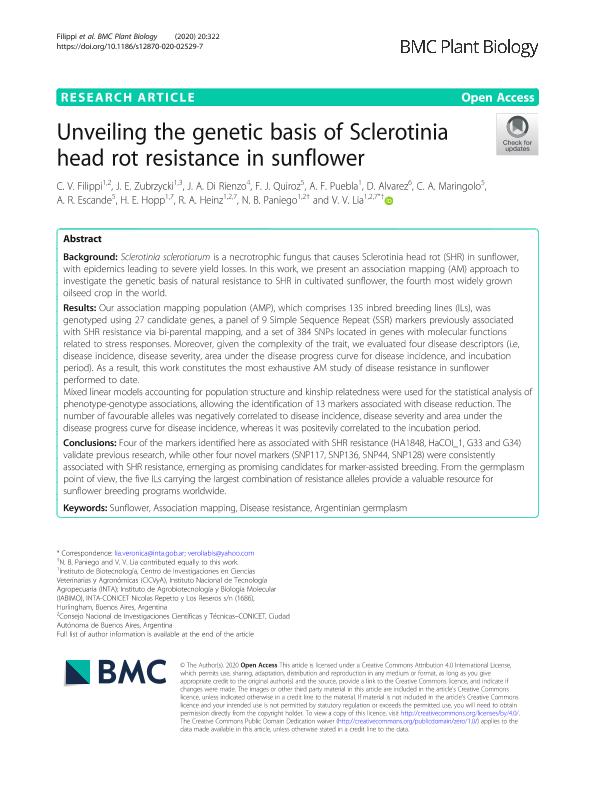Mostrar el registro sencillo del ítem
dc.contributor.author
Filippi, Carla Valeria

dc.contributor.author
Zubrzycki, Jeremías Enrique

dc.contributor.author
Di Rienzo, Julio Alejandro

dc.contributor.author
Quiroz, Facundo José

dc.contributor.author
Puebla, Andrea Fabiana

dc.contributor.author
Alvarez, D.
dc.contributor.author
Maringolo, C. A.
dc.contributor.author
Escande, Alberto Raul

dc.contributor.author
Hopp, Horacio Esteban

dc.contributor.author
Heinz, Ruth Amelia

dc.contributor.author
Paniego, Norma Beatriz

dc.contributor.author
Lia, Veronica Viviana

dc.date.available
2021-10-04T12:34:31Z
dc.date.issued
2020-07
dc.identifier.citation
Filippi, Carla Valeria; Zubrzycki, Jeremías Enrique; Di Rienzo, Julio Alejandro; Quiroz, Facundo José; Puebla, Andrea Fabiana; et al.; Unveiling the genetic basis of Sclerotinia head rot resistance in sunflower; BioMed Central; BMC Plant Biology; 20; 1; 7-2020; 1-13
dc.identifier.issn
1471-2229
dc.identifier.uri
http://hdl.handle.net/11336/142412
dc.description.abstract
Background: Sclerotinia sclerotiorum is a necrotrophic fungus that causes Sclerotinia head rot (SHR) in sunflower, with epidemics leading to severe yield losses. In this work, we present an association mapping (AM) approach to investigate the genetic basis of natural resistance to SHR in cultivated sunflower, the fourth most widely grown oilseed crop in the world. Results: Our association mapping population (AMP), which comprises 135 inbred breeding lines (ILs), was genotyped using 27 candidate genes, a panel of 9 Simple Sequence Repeat (SSR) markers previously associated with SHR resistance via bi-parental mapping, and a set of 384 SNPs located in genes with molecular functions related to stress responses. Moreover, given the complexity of the trait, we evaluated four disease descriptors (i.e, disease incidence, disease severity, area under the disease progress curve for disease incidence, and incubation period). As a result, this work constitutes the most exhaustive AM study of disease resistance in sunflower performed to date. Mixed linear models accounting for population structure and kinship relatedness were used for the statistical analysis of phenotype-genotype associations, allowing the identification of 13 markers associated with disease reduction. The number of favourable alleles was negatively correlated to disease incidence, disease severity and area under the disease progress curve for disease incidence, whereas it was positevily correlated to the incubation period. Conclusions: Four of the markers identified here as associated with SHR resistance (HA1848, HaCOI_1, G33 and G34) validate previous research, while other four novel markers (SNP117, SNP136, SNP44, SNP128) were consistently associated with SHR resistance, emerging as promising candidates for marker-assisted breeding. From the germplasm point of view, the five ILs carrying the largest combination of resistance alleles provide a valuable resource for sunflower breeding programs worldwide.
dc.format
application/pdf
dc.language.iso
eng
dc.publisher
BioMed Central

dc.rights
info:eu-repo/semantics/openAccess
dc.rights.uri
https://creativecommons.org/licenses/by/2.5/ar/
dc.subject
ARGENTINIAN GERMPLASM
dc.subject
ASSOCIATION MAPPING
dc.subject
DISEASE RESISTANCE
dc.subject
SUNFLOWER
dc.subject.classification
Tecnología GM, clonación de ganado, selección asistida, diagnósticos, tecnología de producción de biomasa, etc.

dc.subject.classification
Biotecnología Agropecuaria

dc.subject.classification
CIENCIAS AGRÍCOLAS

dc.title
Unveiling the genetic basis of Sclerotinia head rot resistance in sunflower
dc.type
info:eu-repo/semantics/article
dc.type
info:ar-repo/semantics/artículo
dc.type
info:eu-repo/semantics/publishedVersion
dc.date.updated
2021-09-07T15:00:32Z
dc.journal.volume
20
dc.journal.number
1
dc.journal.pagination
1-13
dc.journal.pais
Reino Unido

dc.journal.ciudad
Londres
dc.description.fil
Fil: Filippi, Carla Valeria. Instituto Nacional de Tecnología Agropecuaria. Centro de Investigación en Ciencias Veterinarias y Agronómicas. Instituto de Agrobiotecnología y Biología Molecular. Consejo Nacional de Investigaciones Científicas y Técnicas. Oficina de Coordinación Administrativa Parque Centenario. Instituto de Agrobiotecnología y Biología Molecular; Argentina
dc.description.fil
Fil: Zubrzycki, Jeremías Enrique. Instituto Nacional de Tecnología Agropecuaria. Centro de Investigación en Ciencias Veterinarias y Agronómicas. Instituto de Agrobiotecnología y Biología Molecular. Consejo Nacional de Investigaciones Científicas y Técnicas. Oficina de Coordinación Administrativa Parque Centenario. Instituto de Agrobiotecnología y Biología Molecular; Argentina
dc.description.fil
Fil: Di Rienzo, Julio Alejandro. Universidad Nacional de Córdoba. Facultad de Ciencias Agropecuarias; Argentina
dc.description.fil
Fil: Quiroz, Facundo José. Instituto Nacional de Tecnología Agropecuaria. Centro Regional Buenos Aires Sur. Estación Experimental Agropecuaria Balcarce; Argentina
dc.description.fil
Fil: Puebla, Andrea Fabiana. Instituto Nacional de Tecnología Agropecuaria. Centro de Investigación en Ciencias Veterinarias y Agronómicas. Instituto de Agrobiotecnología y Biología Molecular. Consejo Nacional de Investigaciones Científicas y Técnicas. Oficina de Coordinación Administrativa Parque Centenario. Instituto de Agrobiotecnología y Biología Molecular; Argentina
dc.description.fil
Fil: Alvarez, D.. Instituto Nacional de Tecnología Agropecuaria. Centro Regional Córdoba. Estación Experimental Agropecuaria Manfredi; Argentina
dc.description.fil
Fil: Maringolo, C. A.. Instituto Nacional de Tecnología Agropecuaria. Centro Regional Buenos Aires Sur. Estación Experimental Agropecuaria Balcarce; Argentina
dc.description.fil
Fil: Escande, Alberto Raul. Instituto Nacional de Tecnología Agropecuaria. Centro Regional Buenos Aires Sur. Estación Experimental Agropecuaria Balcarce; Argentina
dc.description.fil
Fil: Hopp, Horacio Esteban. Instituto Nacional de Tecnología Agropecuaria. Centro de Investigación en Ciencias Veterinarias y Agronómicas. Instituto de Agrobiotecnología y Biología Molecular. Consejo Nacional de Investigaciones Científicas y Técnicas. Oficina de Coordinación Administrativa Parque Centenario. Instituto de Agrobiotecnología y Biología Molecular; Argentina
dc.description.fil
Fil: Heinz, Ruth Amelia. Instituto Nacional de Tecnología Agropecuaria. Centro de Investigación en Ciencias Veterinarias y Agronómicas. Instituto de Agrobiotecnología y Biología Molecular. Consejo Nacional de Investigaciones Científicas y Técnicas. Oficina de Coordinación Administrativa Parque Centenario. Instituto de Agrobiotecnología y Biología Molecular; Argentina
dc.description.fil
Fil: Paniego, Norma Beatriz. Instituto Nacional de Tecnología Agropecuaria. Centro de Investigación en Ciencias Veterinarias y Agronómicas. Instituto de Agrobiotecnología y Biología Molecular. Consejo Nacional de Investigaciones Científicas y Técnicas. Oficina de Coordinación Administrativa Parque Centenario. Instituto de Agrobiotecnología y Biología Molecular; Argentina
dc.description.fil
Fil: Lia, Veronica Viviana. Instituto Nacional de Tecnología Agropecuaria. Centro de Investigación en Ciencias Veterinarias y Agronómicas. Instituto de Agrobiotecnología y Biología Molecular. Consejo Nacional de Investigaciones Científicas y Técnicas. Oficina de Coordinación Administrativa Parque Centenario. Instituto de Agrobiotecnología y Biología Molecular; Argentina
dc.journal.title
BMC Plant Biology

dc.relation.alternativeid
info:eu-repo/semantics/altIdentifier/url/https://bmcplantbiol.biomedcentral.com/articles/10.1186/s12870-020-02529-7
dc.relation.alternativeid
info:eu-repo/semantics/altIdentifier/doi/http://dx.doi.org/10.1186/s12870-020-02529-7
Archivos asociados
